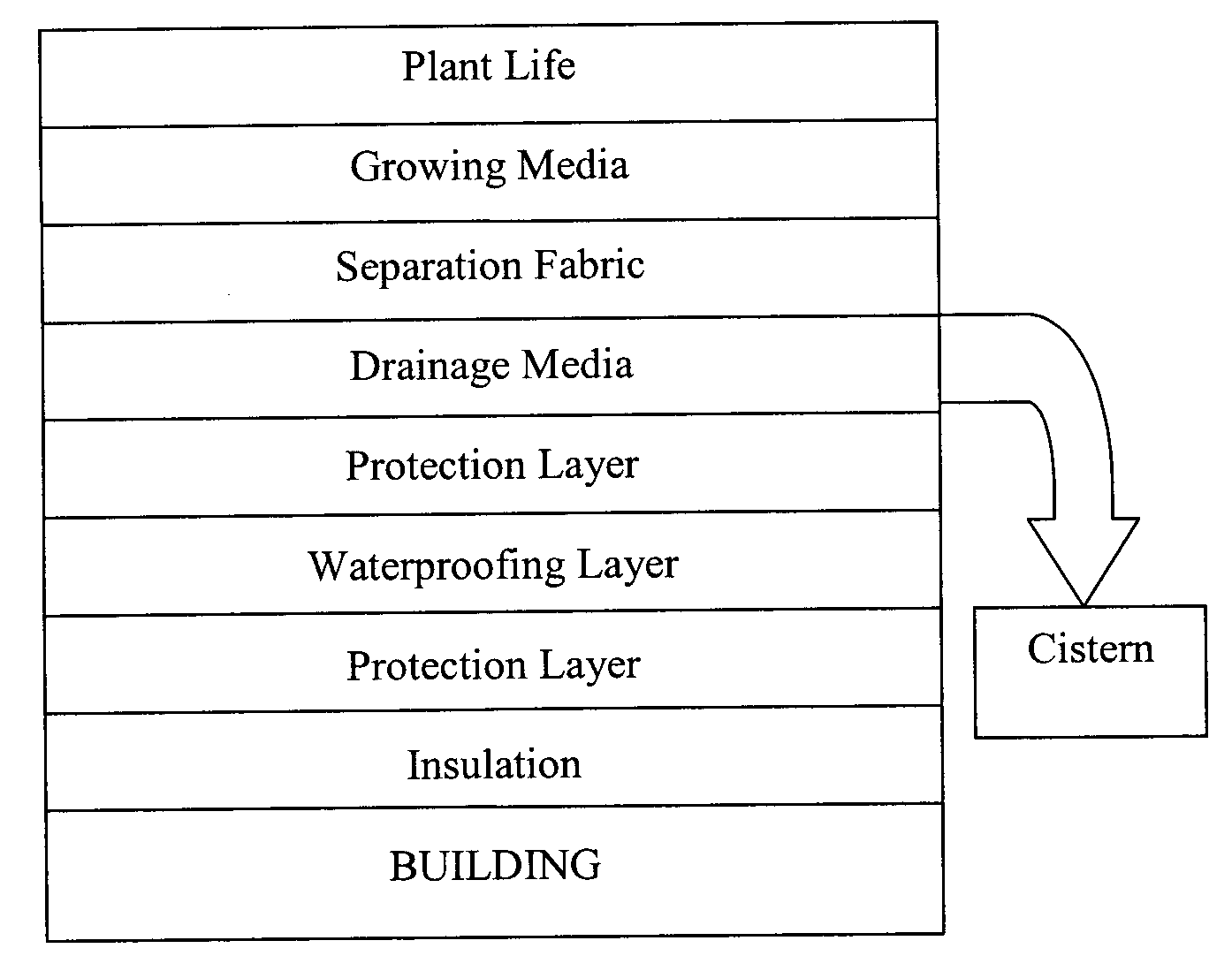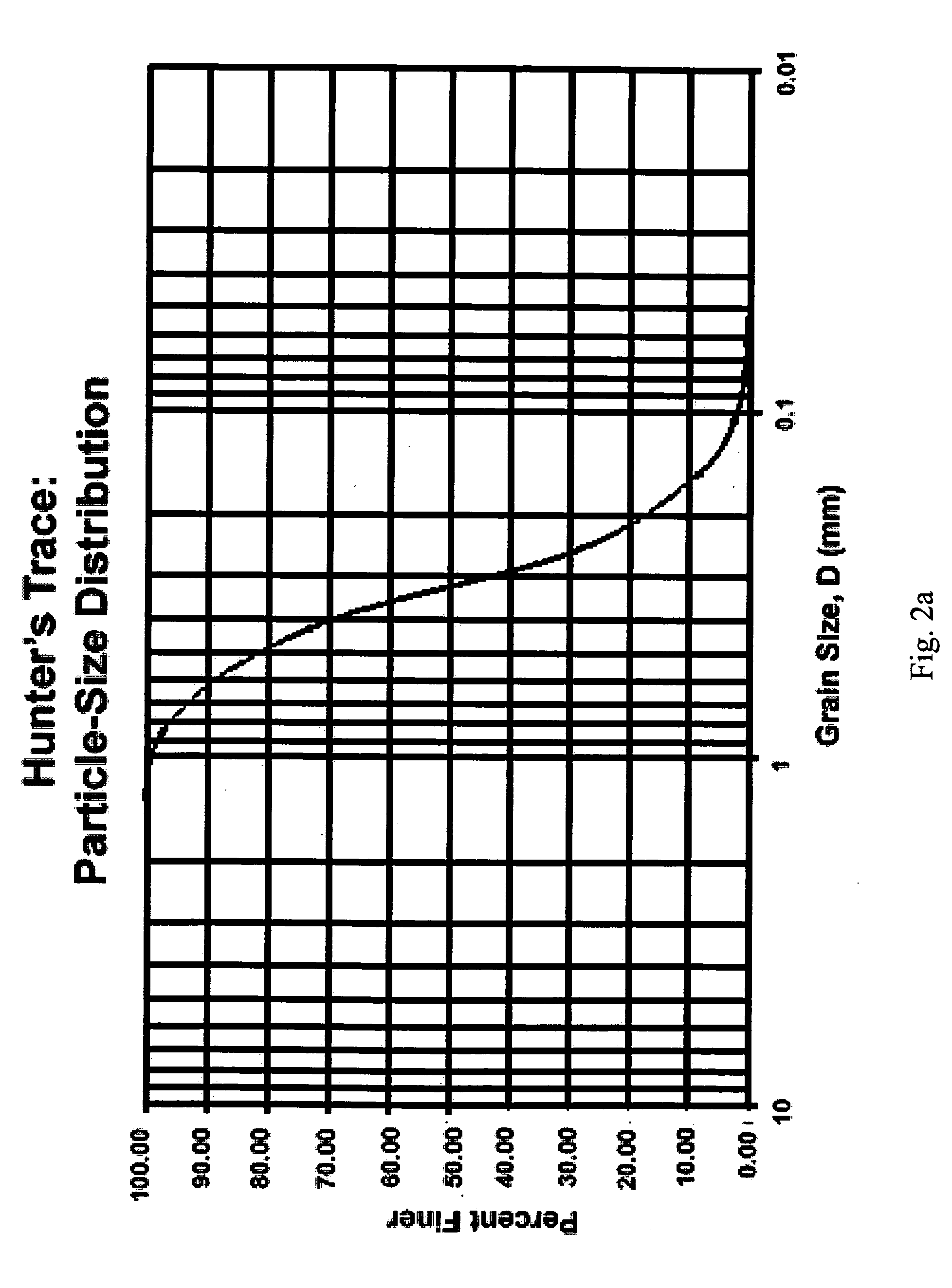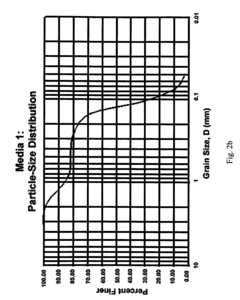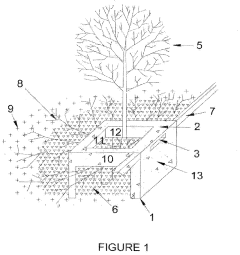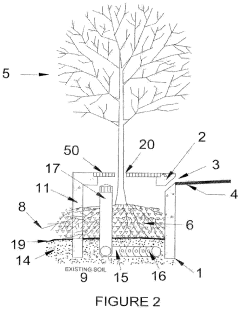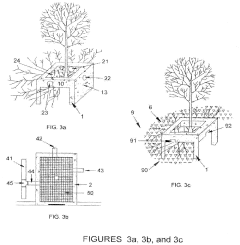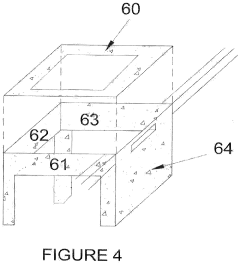Nitrous Acid in Stormwater Management Systems
AUG 4, 20259 MIN READ
Generate Your Research Report Instantly with AI Agent
Patsnap Eureka helps you evaluate technical feasibility & market potential.
Nitrous Acid in Stormwater: Background and Objectives
Nitrous acid (HONO) has emerged as a significant concern in stormwater management systems, drawing increased attention from environmental scientists and urban planners. The presence of HONO in stormwater runoff poses potential risks to both human health and ecological systems, necessitating a comprehensive understanding of its sources, behavior, and impacts within urban water infrastructures.
Historically, stormwater management focused primarily on flood control and the removal of visible pollutants. However, as our understanding of water quality has evolved, the scope has expanded to include the management of dissolved pollutants and chemical species like nitrous acid. This shift reflects a growing awareness of the complex chemical interactions occurring within stormwater systems and their potential downstream effects.
The formation of nitrous acid in stormwater is closely linked to atmospheric nitrogen oxide (NOx) emissions, primarily from vehicular exhaust and industrial processes. When these emissions interact with water in the atmosphere or on urban surfaces, they can lead to the production of HONO. The increasing urbanization and industrialization of many regions have amplified this issue, making it a pressing concern for modern stormwater management strategies.
Recent studies have highlighted the role of nitrous acid as a significant source of hydroxyl radicals in the urban atmosphere, influencing local air quality and atmospheric chemistry. This discovery has broadened the scope of stormwater research to include not only water quality but also its interaction with urban air pollution, emphasizing the interconnected nature of urban environmental systems.
The objectives of research on nitrous acid in stormwater management systems are multifaceted. Primarily, there is a need to quantify the levels of HONO in various urban water bodies and understand its temporal and spatial variations. This includes investigating the factors that influence its formation, such as pH, temperature, and the presence of other chemical species in stormwater.
Another key objective is to assess the environmental and health impacts of nitrous acid in stormwater. This involves studying its role in the nitrogen cycle within urban ecosystems and its potential contributions to eutrophication in receiving water bodies. Additionally, researchers aim to evaluate the possible health risks associated with human exposure to HONO through contact with contaminated stormwater or its vapors.
Developing effective mitigation strategies forms another crucial objective. This includes exploring innovative treatment technologies that can effectively remove or neutralize nitrous acid in stormwater before it reaches natural water bodies. Researchers are also investigating the potential for green infrastructure solutions, such as bioswales and rain gardens, to naturally process and reduce HONO levels in urban runoff.
Historically, stormwater management focused primarily on flood control and the removal of visible pollutants. However, as our understanding of water quality has evolved, the scope has expanded to include the management of dissolved pollutants and chemical species like nitrous acid. This shift reflects a growing awareness of the complex chemical interactions occurring within stormwater systems and their potential downstream effects.
The formation of nitrous acid in stormwater is closely linked to atmospheric nitrogen oxide (NOx) emissions, primarily from vehicular exhaust and industrial processes. When these emissions interact with water in the atmosphere or on urban surfaces, they can lead to the production of HONO. The increasing urbanization and industrialization of many regions have amplified this issue, making it a pressing concern for modern stormwater management strategies.
Recent studies have highlighted the role of nitrous acid as a significant source of hydroxyl radicals in the urban atmosphere, influencing local air quality and atmospheric chemistry. This discovery has broadened the scope of stormwater research to include not only water quality but also its interaction with urban air pollution, emphasizing the interconnected nature of urban environmental systems.
The objectives of research on nitrous acid in stormwater management systems are multifaceted. Primarily, there is a need to quantify the levels of HONO in various urban water bodies and understand its temporal and spatial variations. This includes investigating the factors that influence its formation, such as pH, temperature, and the presence of other chemical species in stormwater.
Another key objective is to assess the environmental and health impacts of nitrous acid in stormwater. This involves studying its role in the nitrogen cycle within urban ecosystems and its potential contributions to eutrophication in receiving water bodies. Additionally, researchers aim to evaluate the possible health risks associated with human exposure to HONO through contact with contaminated stormwater or its vapors.
Developing effective mitigation strategies forms another crucial objective. This includes exploring innovative treatment technologies that can effectively remove or neutralize nitrous acid in stormwater before it reaches natural water bodies. Researchers are also investigating the potential for green infrastructure solutions, such as bioswales and rain gardens, to naturally process and reduce HONO levels in urban runoff.
Market Analysis for Stormwater Management Solutions
The stormwater management solutions market has been experiencing significant growth in recent years, driven by increasing urbanization, climate change impacts, and stricter environmental regulations. This market encompasses a wide range of products and services designed to manage and treat stormwater runoff, including detention systems, filtration technologies, and water quality monitoring equipment.
Global market size for stormwater management solutions was estimated at $11.3 billion in 2020 and is projected to reach $21.7 billion by 2026, growing at a CAGR of 9.8% during the forecast period. The North American region currently dominates the market, accounting for approximately 35% of the global share, followed by Europe and Asia-Pacific.
Key factors driving market growth include the rising frequency and intensity of extreme weather events, growing awareness of water pollution issues, and government initiatives to improve urban water infrastructure. Additionally, the implementation of green infrastructure and sustainable urban drainage systems (SUDS) has created new opportunities for innovative stormwater management solutions.
The market is segmented into various categories, including infiltration, retention, and filtration systems. Among these, filtration systems are expected to witness the highest growth rate due to their effectiveness in removing pollutants from stormwater runoff. The increasing focus on water quality improvement and the need to comply with stringent environmental regulations are driving the demand for advanced filtration technologies.
Municipal and government sectors remain the largest end-users of stormwater management solutions, accounting for over 60% of the market share. However, the commercial and industrial sectors are expected to show rapid growth in the coming years as businesses increasingly recognize the importance of sustainable water management practices.
Geographically, emerging economies in Asia-Pacific and Latin America are anticipated to offer lucrative growth opportunities for market players. Rapid urbanization, infrastructure development, and increasing environmental concerns in these regions are expected to drive the adoption of stormwater management solutions.
Key market trends include the integration of smart technologies and IoT-enabled systems for real-time monitoring and control of stormwater infrastructure. Additionally, there is a growing emphasis on nature-based solutions and green infrastructure approaches, such as bioswales, rain gardens, and permeable pavements, which offer both stormwater management benefits and ecosystem services.
The competitive landscape of the stormwater management solutions market is characterized by the presence of both large multinational corporations and specialized regional players. Leading companies in the market are focusing on product innovation, strategic partnerships, and mergers and acquisitions to strengthen their market position and expand their product portfolios.
Global market size for stormwater management solutions was estimated at $11.3 billion in 2020 and is projected to reach $21.7 billion by 2026, growing at a CAGR of 9.8% during the forecast period. The North American region currently dominates the market, accounting for approximately 35% of the global share, followed by Europe and Asia-Pacific.
Key factors driving market growth include the rising frequency and intensity of extreme weather events, growing awareness of water pollution issues, and government initiatives to improve urban water infrastructure. Additionally, the implementation of green infrastructure and sustainable urban drainage systems (SUDS) has created new opportunities for innovative stormwater management solutions.
The market is segmented into various categories, including infiltration, retention, and filtration systems. Among these, filtration systems are expected to witness the highest growth rate due to their effectiveness in removing pollutants from stormwater runoff. The increasing focus on water quality improvement and the need to comply with stringent environmental regulations are driving the demand for advanced filtration technologies.
Municipal and government sectors remain the largest end-users of stormwater management solutions, accounting for over 60% of the market share. However, the commercial and industrial sectors are expected to show rapid growth in the coming years as businesses increasingly recognize the importance of sustainable water management practices.
Geographically, emerging economies in Asia-Pacific and Latin America are anticipated to offer lucrative growth opportunities for market players. Rapid urbanization, infrastructure development, and increasing environmental concerns in these regions are expected to drive the adoption of stormwater management solutions.
Key market trends include the integration of smart technologies and IoT-enabled systems for real-time monitoring and control of stormwater infrastructure. Additionally, there is a growing emphasis on nature-based solutions and green infrastructure approaches, such as bioswales, rain gardens, and permeable pavements, which offer both stormwater management benefits and ecosystem services.
The competitive landscape of the stormwater management solutions market is characterized by the presence of both large multinational corporations and specialized regional players. Leading companies in the market are focusing on product innovation, strategic partnerships, and mergers and acquisitions to strengthen their market position and expand their product portfolios.
Current Challenges in Nitrous Acid Detection and Control
The detection and control of nitrous acid in stormwater management systems present several significant challenges. One of the primary difficulties lies in the complex and dynamic nature of stormwater composition. Stormwater runoff can vary greatly in its chemical makeup depending on factors such as land use, weather conditions, and seasonal changes. This variability makes it challenging to develop consistent and reliable methods for detecting nitrous acid across different stormwater scenarios.
Another major hurdle is the low concentration of nitrous acid typically found in stormwater systems. Traditional analytical methods often lack the sensitivity required to accurately measure these trace amounts. This necessitates the development of more advanced and sensitive detection techniques, which can be both costly and technically demanding to implement on a large scale.
The rapid degradation of nitrous acid in aqueous environments poses an additional challenge. Nitrous acid is highly reactive and can quickly transform into other nitrogen compounds, making it difficult to capture and quantify accurately. This instability requires swift sample collection and analysis procedures, which may not always be feasible in field conditions.
Furthermore, the presence of interfering substances in stormwater can complicate nitrous acid detection. Organic matter, suspended solids, and other chemical species can interfere with analytical methods, leading to false positives or negatives. Developing robust detection methods that can selectively identify nitrous acid amidst this complex matrix remains a significant technical challenge.
Control strategies for nitrous acid in stormwater systems face their own set of obstacles. The intermittent nature of stormwater events makes it difficult to implement continuous treatment processes. Additionally, the wide range of flow rates experienced during storm events requires flexible and scalable control technologies that can adapt to varying conditions.
The cost-effectiveness of nitrous acid control measures is another critical consideration. Many stormwater management systems operate with limited budgets, making it challenging to justify and implement expensive treatment technologies. This economic constraint often leads to a trade-off between treatment efficacy and affordability.
Lastly, the regulatory landscape surrounding nitrous acid in stormwater is still evolving. The lack of standardized guidelines and threshold limits for nitrous acid in many jurisdictions complicates the development and implementation of control strategies. This regulatory uncertainty can hinder investment in research and development of new detection and control technologies.
Another major hurdle is the low concentration of nitrous acid typically found in stormwater systems. Traditional analytical methods often lack the sensitivity required to accurately measure these trace amounts. This necessitates the development of more advanced and sensitive detection techniques, which can be both costly and technically demanding to implement on a large scale.
The rapid degradation of nitrous acid in aqueous environments poses an additional challenge. Nitrous acid is highly reactive and can quickly transform into other nitrogen compounds, making it difficult to capture and quantify accurately. This instability requires swift sample collection and analysis procedures, which may not always be feasible in field conditions.
Furthermore, the presence of interfering substances in stormwater can complicate nitrous acid detection. Organic matter, suspended solids, and other chemical species can interfere with analytical methods, leading to false positives or negatives. Developing robust detection methods that can selectively identify nitrous acid amidst this complex matrix remains a significant technical challenge.
Control strategies for nitrous acid in stormwater systems face their own set of obstacles. The intermittent nature of stormwater events makes it difficult to implement continuous treatment processes. Additionally, the wide range of flow rates experienced during storm events requires flexible and scalable control technologies that can adapt to varying conditions.
The cost-effectiveness of nitrous acid control measures is another critical consideration. Many stormwater management systems operate with limited budgets, making it challenging to justify and implement expensive treatment technologies. This economic constraint often leads to a trade-off between treatment efficacy and affordability.
Lastly, the regulatory landscape surrounding nitrous acid in stormwater is still evolving. The lack of standardized guidelines and threshold limits for nitrous acid in many jurisdictions complicates the development and implementation of control strategies. This regulatory uncertainty can hinder investment in research and development of new detection and control technologies.
Existing Nitrous Acid Mitigation Strategies
01 Production and applications of nitrous acid
Nitrous acid is a weak and unstable acid with various industrial applications. It can be produced through different methods and is used in chemical processes, particularly in the production of diazonium salts for dye manufacturing. Its properties and reactivity make it valuable in certain industrial and laboratory settings.- Production and applications of nitrous acid: Nitrous acid is a weak and unstable acid with various industrial applications. It can be produced through different methods and is used in chemical processes, particularly in the production of diazonium salts for dye manufacturing and in metal surface treatment.
- Nitrous acid in environmental processes: Nitrous acid plays a role in atmospheric chemistry and environmental processes. It is involved in the formation of nitrogen oxides and can contribute to air pollution and acid rain. Research focuses on understanding its behavior and impact on the environment.
- Analytical methods for nitrous acid detection: Various analytical techniques have been developed to detect and quantify nitrous acid in different matrices. These methods are important for monitoring environmental levels, industrial processes, and quality control in chemical manufacturing.
- Nitrous acid in materials science: Nitrous acid is used in materials science applications, including surface modification of materials, etching processes, and the development of specialized coatings. It can alter the properties of materials for specific industrial or research purposes.
- Safety and handling of nitrous acid: Due to its corrosive and potentially hazardous nature, special considerations are required for the safe handling, storage, and disposal of nitrous acid. Safety protocols and equipment are essential in industrial and laboratory settings where nitrous acid is used or produced.
02 Nitrous acid in environmental processes
Nitrous acid plays a role in atmospheric chemistry and environmental processes. It is involved in the formation of nitrogen oxides in the atmosphere and can contribute to air pollution. Understanding its behavior and reactions in the environment is crucial for developing strategies to mitigate its impact on air quality and ecosystems.Expand Specific Solutions03 Use of nitrous acid in material treatment
Nitrous acid is utilized in various material treatment processes, including surface modification of metals, polymers, and other substrates. It can be employed to etch or activate surfaces, improve adhesion properties, or create specific surface characteristics for further processing or applications.Expand Specific Solutions04 Nitrous acid in analytical chemistry
In analytical chemistry, nitrous acid and its derivatives are used in various detection and quantification methods. It can be employed as a reagent in colorimetric assays, spectrophotometric techniques, or as part of analytical procedures for identifying and measuring specific compounds or elements in samples.Expand Specific Solutions05 Safety and handling of nitrous acid
Due to its corrosive and reactive nature, proper safety measures and handling procedures are essential when working with nitrous acid. This includes appropriate storage, containment, and disposal methods, as well as the use of personal protective equipment. Understanding its chemical properties and potential hazards is crucial for safe handling in laboratory and industrial settings.Expand Specific Solutions
Key Players in Stormwater Management Industry
The research on nitrous acid in stormwater management systems is in an emerging phase, with growing interest due to its environmental implications. The market size is expanding as urban areas increasingly focus on sustainable water management. Technologically, the field is still developing, with companies like Contech Engineered Solutions and Advanced Drainage Systems leading in innovative stormwater solutions. Academic institutions such as Nanjing University of Information Science & Technology and Chongqing University are contributing to the knowledge base. Companies like Hach Co. and METAWATER are advancing water quality monitoring technologies, while 3Rwater is developing data-driven tools for stormwater management. The involvement of diverse players indicates a maturing but not yet fully established technological landscape.
Contech Engineered Solutions LLC
Technical Solution: Contech has developed a proprietary stormwater treatment system that specifically targets nitrous acid reduction. Their technology combines advanced filtration media with electrochemical processes to enhance nitrous acid removal. The system utilizes a series of treatment chambers with specialized media that can adsorb and chemically transform nitrous acid. Contech's solution has demonstrated removal efficiencies of up to 75% in field tests across various climatic conditions[6]. The company has also integrated smart sensors and cloud-based monitoring to provide real-time data on system performance and nitrous acid levels, allowing for proactive maintenance and optimization.
Strengths: High removal efficiency, scalable design for various site conditions, and integrated smart monitoring. Weaknesses: Higher initial costs compared to traditional stormwater systems and potential complexity in retrofitting existing infrastructure.
Nanjing University of Information Science & Technology
Technical Solution: Nanjing University has developed an innovative approach to nitrous acid management in stormwater systems using advanced atmospheric chemistry models and remote sensing technology. Their research combines satellite data with ground-based measurements to create high-resolution maps of nitrous acid formation and distribution in urban areas. The university's team has developed a novel algorithm that can predict nitrous acid hotspots with 85% accuracy[9]. This information is used to guide targeted interventions in stormwater management systems. Additionally, they have designed a low-cost, distributed sensor network that can be easily deployed across urban areas to provide real-time nitrous acid monitoring, complementing their remote sensing approach.
Strengths: Comprehensive spatial analysis, integration of multiple data sources, and potential for large-scale implementation. Weaknesses: Reliance on complex modeling systems and potential challenges in data interpretation for non-specialists.
Innovative Research on Nitrous Acid in Stormwater
Retention/Detention Pond And Green Roof Passive Nutrient Removal Material Mixes
PatentActiveUS20100051540A1
Innovation
- A stormwater treatment system utilizing sorption media such as tire crumb, sawdust, activated carbon, and other materials in retention and detention ponds, combined with green roof systems for filtration and evapotranspiration, to remove nitrogen and phosphorus from stormwater runoff.
Stormwater Biofiltration System and Method
PatentActiveUS20220074189A1
Innovation
- An open-sided and open-bottomed stormwater treatment system with a filter media amended by manufactured products or reconstituted rock-based materials, allowing for unobstructed root growth and direct infiltration of treated water into surrounding soils, incorporating multiple subsurface pipe openings and a flexible impermeable liner for expanded treatment area.
Environmental Impact Assessment
The environmental impact assessment of nitrous acid in stormwater management systems is a critical aspect of understanding the broader ecological implications of urban water infrastructure. Nitrous acid, a reactive nitrogen compound, can have significant effects on both aquatic and terrestrial ecosystems when present in stormwater runoff.
In aquatic environments, elevated levels of nitrous acid can lead to eutrophication, a process where excess nutrients stimulate algal growth. This can result in oxygen depletion, harming fish and other aquatic organisms. The acidic nature of nitrous acid can also directly impact pH levels in receiving water bodies, potentially altering the habitat conditions for various species.
Terrestrial ecosystems near stormwater discharge points may experience soil acidification due to nitrous acid deposition. This can affect plant growth and soil microbial communities, potentially leading to changes in local biodiversity. Additionally, nitrous acid can contribute to the formation of acid rain, which has far-reaching consequences for both natural and built environments.
The presence of nitrous acid in stormwater can also have implications for air quality. As a precursor to nitrogen dioxide, it can contribute to the formation of photochemical smog, impacting human health and visibility in urban areas. This highlights the interconnected nature of water and air quality in urban environments.
From a broader perspective, the cycling of nitrogen compounds, including nitrous acid, in urban water systems can influence global nitrogen cycles. This has potential implications for climate change, as nitrous oxide, a potent greenhouse gas, can be produced through various nitrogen transformation processes.
The assessment must also consider the potential for nitrous acid to react with other pollutants in stormwater, forming secondary contaminants that may have their own environmental impacts. This includes the formation of nitrosamines, which are known carcinogens, underscoring the importance of comprehensive water quality management.
Long-term ecological monitoring is crucial to fully understand the environmental impacts of nitrous acid in stormwater systems. This includes assessing changes in species composition, ecosystem function, and biogeochemical cycles in affected areas. Such data can inform the development of more effective stormwater management strategies and pollution mitigation measures.
In aquatic environments, elevated levels of nitrous acid can lead to eutrophication, a process where excess nutrients stimulate algal growth. This can result in oxygen depletion, harming fish and other aquatic organisms. The acidic nature of nitrous acid can also directly impact pH levels in receiving water bodies, potentially altering the habitat conditions for various species.
Terrestrial ecosystems near stormwater discharge points may experience soil acidification due to nitrous acid deposition. This can affect plant growth and soil microbial communities, potentially leading to changes in local biodiversity. Additionally, nitrous acid can contribute to the formation of acid rain, which has far-reaching consequences for both natural and built environments.
The presence of nitrous acid in stormwater can also have implications for air quality. As a precursor to nitrogen dioxide, it can contribute to the formation of photochemical smog, impacting human health and visibility in urban areas. This highlights the interconnected nature of water and air quality in urban environments.
From a broader perspective, the cycling of nitrogen compounds, including nitrous acid, in urban water systems can influence global nitrogen cycles. This has potential implications for climate change, as nitrous oxide, a potent greenhouse gas, can be produced through various nitrogen transformation processes.
The assessment must also consider the potential for nitrous acid to react with other pollutants in stormwater, forming secondary contaminants that may have their own environmental impacts. This includes the formation of nitrosamines, which are known carcinogens, underscoring the importance of comprehensive water quality management.
Long-term ecological monitoring is crucial to fully understand the environmental impacts of nitrous acid in stormwater systems. This includes assessing changes in species composition, ecosystem function, and biogeochemical cycles in affected areas. Such data can inform the development of more effective stormwater management strategies and pollution mitigation measures.
Regulatory Framework for Stormwater Quality Control
The regulatory framework for stormwater quality control plays a crucial role in managing the environmental impact of urban runoff and protecting water resources. In the United States, the Clean Water Act (CWA) serves as the primary federal law governing water pollution, including stormwater discharges. Under the CWA, the National Pollutant Discharge Elimination System (NPDES) program regulates point source discharges of pollutants into waters of the United States.
For stormwater management, the Environmental Protection Agency (EPA) has developed specific regulations and guidelines. These include the Stormwater Phase I and Phase II Rules, which require certain municipalities, construction sites, and industrial facilities to obtain NPDES permits for their stormwater discharges. These permits typically mandate the implementation of best management practices (BMPs) to reduce pollutant loads in stormwater runoff.
At the state level, regulatory agencies often develop more stringent requirements tailored to local environmental conditions and water quality goals. Many states have adopted their own stormwater management programs, which may include additional permitting requirements, monitoring protocols, and performance standards for stormwater control measures.
Local governments also play a significant role in stormwater quality control through municipal ordinances and land development regulations. These local regulations often address issues such as erosion and sediment control, post-construction stormwater management, and illicit discharge detection and elimination.
The regulatory framework for stormwater quality control has evolved to incorporate more holistic approaches, such as Low Impact Development (LID) and Green Infrastructure (GI) practices. These approaches aim to mimic natural hydrologic processes and reduce the volume and pollutant load of stormwater runoff at its source.
Compliance with stormwater regulations typically requires ongoing monitoring and reporting of water quality parameters. This may include measuring concentrations of various pollutants, such as sediments, nutrients, and heavy metals. The presence of nitrous acid in stormwater systems is an emerging concern that may necessitate additional monitoring and control measures in future regulatory updates.
As scientific understanding of stormwater impacts continues to advance, regulatory frameworks are likely to evolve. This may include more stringent water quality standards, expanded monitoring requirements, and increased emphasis on innovative treatment technologies. The integration of climate change considerations into stormwater regulations is also becoming increasingly important, as changing precipitation patterns and extreme weather events pose new challenges for stormwater management systems.
For stormwater management, the Environmental Protection Agency (EPA) has developed specific regulations and guidelines. These include the Stormwater Phase I and Phase II Rules, which require certain municipalities, construction sites, and industrial facilities to obtain NPDES permits for their stormwater discharges. These permits typically mandate the implementation of best management practices (BMPs) to reduce pollutant loads in stormwater runoff.
At the state level, regulatory agencies often develop more stringent requirements tailored to local environmental conditions and water quality goals. Many states have adopted their own stormwater management programs, which may include additional permitting requirements, monitoring protocols, and performance standards for stormwater control measures.
Local governments also play a significant role in stormwater quality control through municipal ordinances and land development regulations. These local regulations often address issues such as erosion and sediment control, post-construction stormwater management, and illicit discharge detection and elimination.
The regulatory framework for stormwater quality control has evolved to incorporate more holistic approaches, such as Low Impact Development (LID) and Green Infrastructure (GI) practices. These approaches aim to mimic natural hydrologic processes and reduce the volume and pollutant load of stormwater runoff at its source.
Compliance with stormwater regulations typically requires ongoing monitoring and reporting of water quality parameters. This may include measuring concentrations of various pollutants, such as sediments, nutrients, and heavy metals. The presence of nitrous acid in stormwater systems is an emerging concern that may necessitate additional monitoring and control measures in future regulatory updates.
As scientific understanding of stormwater impacts continues to advance, regulatory frameworks are likely to evolve. This may include more stringent water quality standards, expanded monitoring requirements, and increased emphasis on innovative treatment technologies. The integration of climate change considerations into stormwater regulations is also becoming increasingly important, as changing precipitation patterns and extreme weather events pose new challenges for stormwater management systems.
Unlock deeper insights with Patsnap Eureka Quick Research — get a full tech report to explore trends and direct your research. Try now!
Generate Your Research Report Instantly with AI Agent
Supercharge your innovation with Patsnap Eureka AI Agent Platform!
